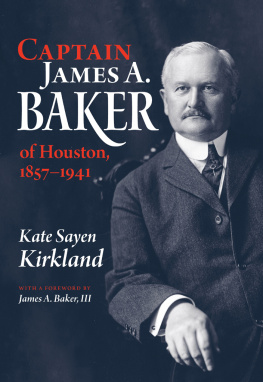Baker & Botts
in the Development
of Modern Houston
by Kenneth Lipartito
and Joseph Pratt
University of Texas Press, Austin
Copyright 1991 by Kenneth Lipartito and Joseph Pratt
All rights reserved
First Edition, 1991
Requests for permission to reproduce material
from this work should be sent to Permissions,
University of Texas Press, Box 7819, Austin, Texas 78713-7819.
utpress.utexas.edu/index.php/rp-form
Library of Congress Cataloging-in-Publication Data
Library ebook ISBN: 978-1-4773-0119-7
Individual ebook ISBN: 978-1-4773-0120-3
DOI: 10.7560/707825
Lipartito, Kenneth, 1957
Baker & Botts in the development of modern Houston / by Kenneth Lipartito and Joseph Pratt. 1st ed.
p. cm.
Includes bibliographical references and index.
ISBN 0-292-70782-7 (alk. paper)
1. Baker & BottsHistory. 2. Law firmsTexasHoustonHistory. 3. Houston (Tex.)History. I. Pratt, Joseph A. II. Title. III. Title: Baker and Botts in the development of modern Houston.
KF355.H68L56 1991
340.0607641411dc20
90-48256
CIP
Frontispiece: One Shell Plaza
Contents
Illustrations
FIGURE
TABLES
T HIS IS THE HISTORY of a major Houston law firmand more. Baker & Botts was founded as a two-member partnership in the early nineteenth century. It has since grown into an organization of more than 370 lawyers with offices in Houston, Washington, D.C., Dallas, and Austin. In the 1980s the firm was in the public eye as counsel for Pennzoils successful effort to recover billions of dollars in damages from Texaco over the acquisition of the Getty Oil Company. But for most of its history, Baker & Botts has remained outside the spotlight, quietly handling legal affairs for such blue-chip clients as the Southern Pacific Railroad (SP), Houston Lighting & Power Company (HL&P), and Tenneco, Inc. As Houstons oldest corporate law practice, Baker & Botts has long occupied a prominent place in the citys legal, economic, and civic life. We have tried to capture a sense of the complex interrelationships between Houstons emergence as a modern city and Baker & Bottss growth into a national law firm.
shows the evolution of the firms official name, for most of its history the firm has been known as Baker & Botts or Baker, Botts.
Given the firms long history and its parallel development with Houston, it is not surprising that the initial impulse for writing this history came from Baker & Botts. As the firm approached its 150th anniversary, the partners quite naturally felt an impulse to pause and look back over the terrain their organization has traveled. Yet the decision to commission a professional history was by no means an exercise in either nostalgia or self-congratulation. In recent decades, Baker & Botts and the legal profession as a whole have been challenged by far-reaching changes in the practice of law. In the midst of such change, history is more than comforting; it can be instructive. The broad contours of the firms past provide a useful context for contemplating the pace and direction of change in the future. A historical understanding of the organizational structure of the firm helps to identify traditional strengths. A study of its diverse roles in the development of the Gulf region adds a much-needed long-term perspective to any discussion of the ongoing relationship between Baker & Botts and its home base of Houston.
Once the firm decided to commission the writing of a professional history, it did not have to look far for a historian. Joseph Pratt was in the Baker & Botts archives completing research on a history of Texas Commerce Banks, a major Houston-based bank holding company, which was a long-standing client of the firm. Preliminary discussions led to a practical plan: an oral history project, which would be accompanied by a survey of archival sources to determine the feasibility of writing a full-scale firm history. As the interviews moved forward, the potential for a book became clearer. Pratt, a business historian whose previous work had focused on the history of the oil industry and the development of Houston, was soon joined by Kenneth Lipartito, a historian of the American economy, who had just completed a study of the telephone industry in the South. Together, these coauthors planned the history project.
The contract between the coauthors and the firm granted the authors full editorial control and final disposition of the manuscript. It also assured them full access to firm records and personnel, as conditioned by the constraints necessarily imposed by the confidentiality of client records. Under the contract, Baker & Botts provided funds for Pratt to take time off from his teaching position at the University of Houston, for Lipartito to devote two years to the project (during which time he was an employee of Baker & Botts), and for a part-time research assistant. The coauthors agreed to produce a university press-quality history of the firm. Appended to the contract was a chapter outline for the project developed by the coauthors and reviewed by the firm. By anticipating areas of possible conflict before research began in earnest, the contract laid the foundation for a smooth working relationship between the authors and Baker & Botts.
TABLE 1
DEVELOPMENT OF FIRM NAME
Name | Years Used |
Gray & Botts | 18651872 |
Gray, Botts & Baker | 18721875 |
Baker & Botts | 18751887 |
Baker, Botts & Baker | 18871893 |
Baker, Botts, Baker & Lovett | 18931904 |
Baker, Botts, Parker & Garwood | 19041931 |
Baker, Botts, Andrews & Wharton | 19311946 |
Baker, Botts, Andrews & Walne | 19461947 |
Baker, Botts, Andrews & Parish | 19481953 |
Baker, Botts, Andrews & Shepherd | 19541962 |
Baker, Botts, Shepherd & Coates | 19621970 |
Baker & Botts | 1971 |
As work began, the authors soon recognized that Baker & Botts was an excellent vehicle for studying the process of economic and business development in Houston. The members of the firm were active in the legal affairs of many of the major corporations that shaped the early growth of Houston; thus, much of the citys economic life flowed through the officesand through the recordsof this firm. These lawyers were in a crucial position to encourage the absorption of their region into the modern American economy.
So vital was their influence, indeed, that some thoughtful readers may wonder if the authors claim too much, if their emphasis has been skewed by their access to the heretofore untouched historical records from one group of lawyers. After all, lawyers have seldom played such a central role in the published histories of Americas economic and urban development. Yet the authors invite the reader to entertain these thoughts: the sources needed to describe the roles of lawyers have not been available to researchers; historians have thus concentrated instead on the activities of politicians, whose records are in the public domain, or flamboyant big business executives, whose activities could be followed through court and regulatory archives. With so few thorough studies of the histories of major law firms, it is not surprising that the impact of lawyers on history is so little understood and so often neglected. Time and again the historical sources suggest that the power of lawyers has always been acknowledged and often feared by their contemporaries. We trust that this study of one major corporate law firm in one developing city can help place the influence of these partnerships in proper historical perspective.














